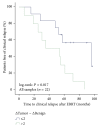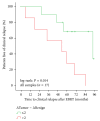The role of androgen receptor expression in the curative treatment of prostate cancer with radiotherapy: a pilot study
- PMID: 25793207
- PMCID: PMC4352440
- DOI: 10.1155/2015/812815
The role of androgen receptor expression in the curative treatment of prostate cancer with radiotherapy: a pilot study
Abstract
The androgen receptor (AR) and its signaling pathway play an important role in the development and progression of prostate cancer (PCa). In the setting of primary treatment of PCa with radiotherapy (RT), where the AR can be expected to be of more importance, studies evaluating the AR expression are lacking. The goal of this research is to evaluate AR protein expression in hormone-naive PCa patients treated by RT and investigate its possible prognostic role. Primary biopsy samples of 18 patients treated with primary RT were analyzed including the corresponding clinical information. AR protein expression of the tumor epithelium (with highest Gleason pattern) and the surrounding stroma was quantified using the Quick score for steroid receptors. The differential expression between epithelium and stroma, respectively, between tumor and normal tissue (ΔTumor - ΔBenign >2 versus ≤ 2), was predictive for clinical progression-free survival in the biopsy samples (P = 0.014). Preliminary results of this research show already a promising role of differential AR expression in predicting clinical relapse after PCa treatment with primary EBRT. Further research is needed to validate these findings. Hopefully this can lead to a better understanding of PCa evolution and eventually lead to better therapy strategies.
Figures





References
-
- Wein A. J., Kavoussi L. R., Novick A. C., Partin A. W., Peters C. A. Molecular biology, and physiology of the prostate. In: Berman D. M., editor. Campbell-Walsh Urology. 10th. Philadelphia, Pa, USA: WB Saunders; 2011.
-
- Meng M. V., Carroll P. M. Treatment of locally advanced prostate cancer. In: Wein A. J., Kavoussi L. R., Novick A. C., Partin A. W., Peters C. A., editors. Campbell-Walsh Urology. 10th. Philadelphia, Pa, USA: WB Saunders; 2011.
MeSH terms
Substances
LinkOut - more resources
Full Text Sources
Other Literature Sources
Medical
Research Materials

